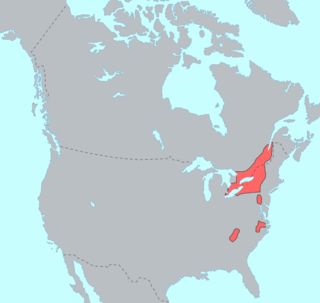
The Tuscarora are an Indigenous people of the Northeastern Woodlands in Canada and the United States. They are an Iroquoian Native American and First Nations people, based in New York and Ontario.

Tuscarora is a census-designated place (CDP) that is located in Schuylkill County, Pennsylvania, United States. The population was 980 at the time of the 2010 census.

The Tuscarora Trail is a 252-mile (406 km) hiking trail in the eastern United States, following the Appalachian Mountains through portions of Virginia, West Virginia, Maryland, and Pennsylvania. Its route is roughly parallel to, and to the west of, the Appalachian Trail.

Thayendanegea or Joseph Brant was a Mohawk military and political leader, based in present-day New York and, later, Brantford, in what is today Ontario, who was closely associated with Great Britain during and after the American Revolution. Perhaps the best known Native American of his generation, he met many of the most significant American and British people of the age, including both United States President George Washington and King George III of Great Britain.

Lewiston is a village in Niagara County, New York, United States. The population was 2,701 at the 2010 census. The village is named after Morgan Lewis, an early 19th-century governor of New York. It is part of the Buffalo–Niagara Falls Metropolitan Statistical Area.

The Grand River, formerly known as the River Ouse, is a large river in Ontario, Canada. It lies along the western fringe of the Greater Golden Horseshoe region of Ontario which overlaps the eastern portion of southwestern Ontario, sometimes referred to as Midwestern Ontario, along the length of this river. From its source near Wareham, Ontario, it flows south through Grand Valley, Fergus, Elora, Waterloo, Kitchener, Cambridge, Paris, Brantford, Ohsweken, Six Nations of the Grand River, Caledonia, and Cayuga before emptying into the north shore of Lake Erie south of Dunnville at Port Maitland. One of the scenic and spectacular features of the river is the falls and Gorge at Elora.

The Onondaga people are one of the five original nations of the Haudenosaunee (Iroquois) Confederacy in the Northeastern Woodlands. Their historical homelands are in and around present-day Onondaga County, New York, south of Lake Ontario.

Six Nations is demographically the largest First Nations reserve in Canada. As of the end of 2017, it has a total of 27,276 members, 12,848 of whom live on the reserve. These nations are the Mohawk, Cayuga, Onondaga, Oneida, Seneca and Tuscarora. Some Lenape live in the territory as well.
Six Nations may refer to:

The Iroquoian languages are a language family of indigenous peoples of North America. They are known for their general lack of labial consonants. The Iroquoian languages are polysynthetic and head-marking.

The Tuscarora War was fought in North Carolina from September 10, 1711, until February 11, 1715, between the Tuscarora people and their allies on one side and European American settlers, the Yamasee, and other allies on the other. This was considered the bloodiest colonial war in North Carolina. The Tuscarora signed a treaty with colonial officials in 1718 and settled on a reserved tract of land in Bertie County, North Carolina. The war incited further conflict on the part of the Tuscarora and led to changes in the slave trade of North and South Carolina.
First Nations in Ontario constitute many nations. Common First Nations ethnicities in the province include the Anishinaabe, Haudenosaunee, and the Cree. In southern portions of this province, there are reserves of the Mohawk, Cayuga, Onondaga, Oneida, Seneca and Tuscarora.

Tuscarora, sometimes called Skarò˙rə̨ˀ, was the Iroquoian language of the Tuscarora people, spoken in southern Ontario, Canada, North Carolina and northwestern New York around Niagara Falls, in the United States, before becoming extinct in late 2020. The historic homeland of the Tuscarora was in eastern North Carolina, in and around the Goldsboro, Kinston, and Smithfield areas.
Tuscarora State Forest is a Pennsylvania state forest in Pennsylvania Bureau of Forestry District #3. The main office is located in Blain in Perry County, Pennsylvania in the United States.
Mississaugas of the Credit First Nation is a Mississaugas, an Ojibwe sub-group, First Nation located near Brantford in south-central Ontario, Canada. In April 2015, MCFN had an enrolled population of 2,330 people, 850 of whom lived on the MCFN Reserve. The first nation governs the 2,392.6 ha parcel of New Credit 40A Indian Reserve known as Reserve 40B near Hagersville, Ontario. This reserve is located beside the Six Nations of the Grand River, near Brantford.

The Seneca–Cayuga Nation is one of three federally recognized tribes of Seneca people in the United States. It includes the Cayuga people and is based in Oklahoma, United States. The tribe had more than 5,000 people in 2011. They have a tribal jurisdictional area in the northeast corner of Oklahoma and are headquartered in Grove. They are descended from Iroquoian peoples who had relocated to Ohio from New York state in the mid-18th century.

The Iroquois, also known as the Five Nations, and later as the Six Nations from 1722 onwards; alternatively referred to by the endonym Haudenosaunee are an Iroquoian-speaking confederacy of Native Americans and First Nations peoples in northeast North America. They were known by the French during the colonial years as the Iroquois League, and later as the Iroquois Confederacy, while the English simply called them the "Five Nations". The peoples of the Iroquois included the Mohawk, Oneida, Onondaga, Cayuga, and Seneca. After 1722, the Iroquoian-speaking Tuscarora people from the southeast were accepted into the confederacy, from which point it was known as the "Six Nations".

Six Nations Polytechnic (SNP) is a Haudenosaunee-governed Indigenous institute on Six Nations of the Grand River First Nation. SNP is an Indigenous Institute, the third pillar of post-secondary education in Ontario, as recognized by the Indigenous Institutes Act of 2017, The Six Nations of the Grand River First Nation are the Mohawk, Cayuga, Onondaga, Oneida, Seneca, and Tuscarora. The Six Nations of the Grand River First Nation reserve acreage at present covers some 46,000 acres (190 km2) near the city of Brantford, Ontario. Six Nations Polytechnic has two campuses, one located in Ohsweken and one located in Brantford.
Rebecca Jamieson is a Canadian Tuscarora educator and education administrator. Since the late 1970s she has worked to improve access to education on Six Nations of the Grand River, the most-populous First Nations reserve in Canada. Jamieson helped to found Six Nations Polytechnic (SNP), an indigenous educational institution, and has been its president and CEO since 2009.













